At Realms of Gold stuffed toy hospital, animals and dolls come out rejuvenated
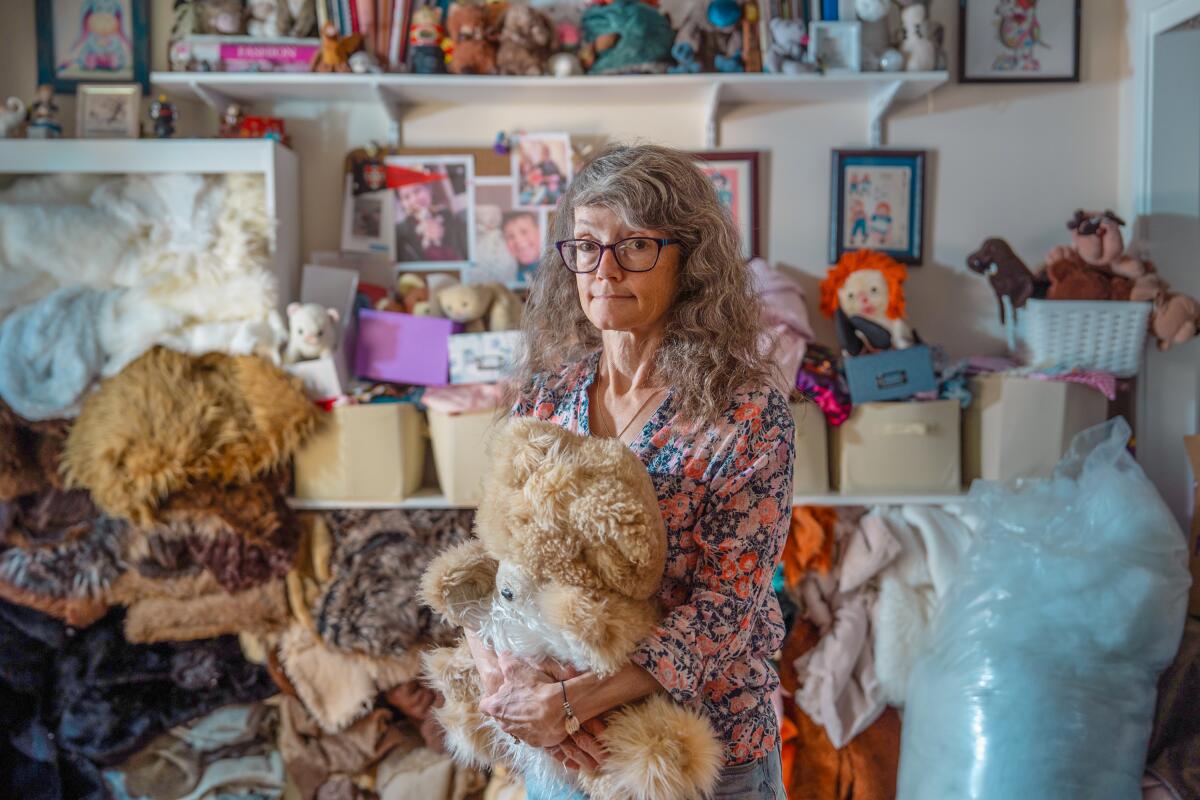
Torn, falling apart, heavily-hugged and well-loved toys come from all over the world to the Realms of Gold stuffed animal and doll hospital in Los Altos.
- Share via
Some arrive with the love nearly squeezed out of them. Some have had run-ins with family pets. Some have survived natural disasters. Some have been mangled in the washing machine or burned in the dryer. Some arrive in pieces. Some are literally on their last thread.
But no matter how they arrive, Beth Karpas makes those beloved stuffed animals and dolls feel like new again at Realms of Gold, the toy hospital she runs out of her home studio in Los Altos. It’s where the torn, falling apart, and heavily-hugged go for love and care.
For the record:
11:28 a.m. Sept. 8, 2023An earlier version of this article misspelled Beth Karpas’ last name as Karper.
You can run into all sorts of patients here — lions, tigers, bears, bunnies, lambs, elephants, cows and other plush pals. More high-profile toy celebrities passing through have included Raggedy Ann, Raggedy Andy, Care Bears, Paddington Bear, Scooby-Doo, Barney, Mickey Mouse, Winnie the Pooh and sometimes Tigger too.
Regardless of a toy’s popularity level, each receives a patient number and is set up in its own space during its stay. Since starting the hospital nearly 20 years ago, Karpas has helped more than 6,000 toy patients from around the world.
People who’ve sent in their stuffed friends have told Karpas that they’ve had them since childhood; others have come from parents who’ve had to dig through rain and mud to find them again; others were left behind on vacation but were shipped home by hotels.
“It’s been everywhere, and it’s part of me, and yet, getting rid of it would almost be like losing part of yourself,” Karpas said people tell her of their dolls and stuffed animals. “There’s also people who are like, literally, this is the only thing they have from their childhood. And sometimes that’s because they’ve just had a busy life and they’re now 80 years old and this is what was left.”
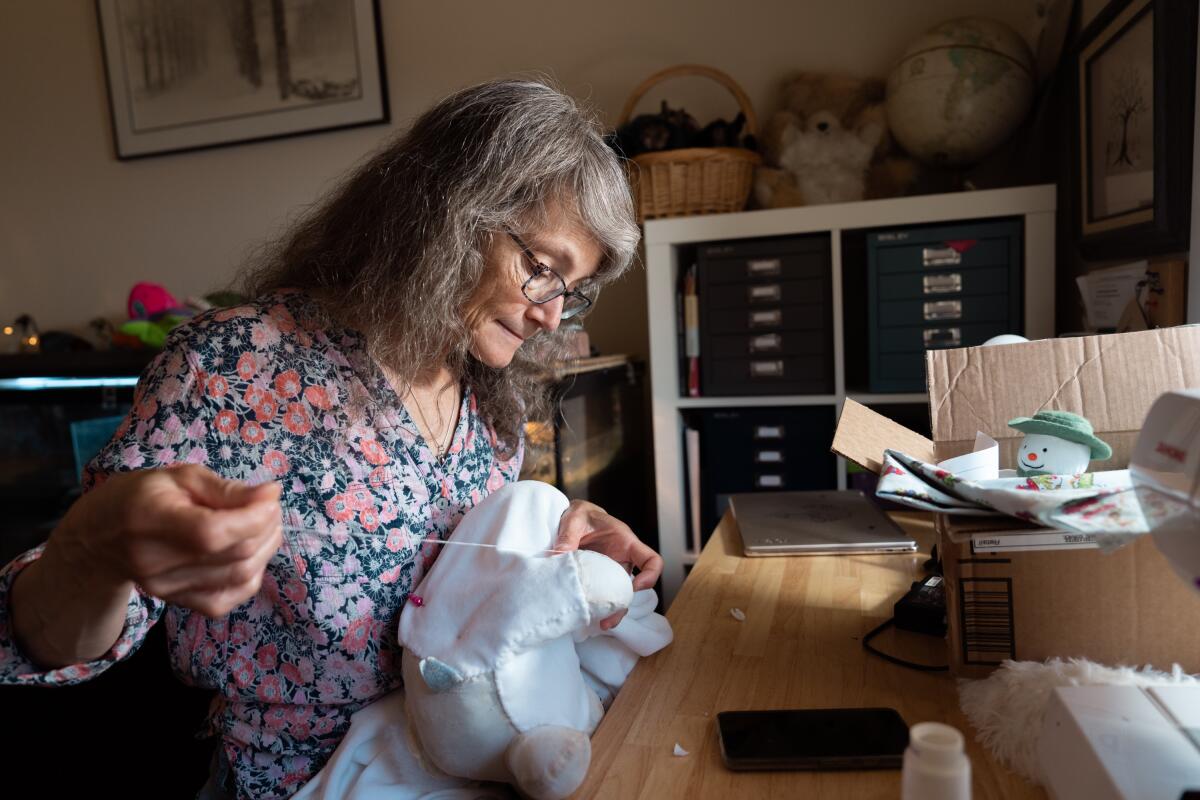
Karpas has been making dolls since she was a child in Maryland. She was a children’s librarian in Ohio making dolls for story time and later on was a librarian for the Braille Institute in Los Angeles before moving to the Bay Area with her husband in 2000. When she left her librarian job, she decided to make dolls full-time, selling them at art shows and online and soon had people asking whether she could repair their stuffed animals and dolls too.
But her desire to help renew the life of dolls and stuffed animals was sealed after the teddy bear she had had since she was a baby was rejected by a repair and restoration store in New York City. The bear had been stitched up “hundreds of times” over the years by her father or grandmother, Karpas said. But she was not comfortable fixing her bear on her own. The rejection was devastating.
“They told me that he wasn’t a fancy enough teddy bear, that they only worked with antique teddy bears, like the old classic jointed ones that you see from the turn of the century,” Karpas said. “They wouldn’t touch him; his fur was too messed up, they couldn’t sell it and they wouldn’t do anything.”
The rejection drove her to become more comfortable with fixing her bear and helping others.
Every patient has a story. Karpas said the toys are sent for a variety of reasons, including somebody going to college or graduating from college, going to boot camp or coming home from a deployment, or the person is getting married and they want their favorite stuffed friend to be there celebrating with them. Other patients are being prepped to be passed along to a new child or grandchild.
“A lot of people anthropomorphize them — this is who has been with them their entire lives,” Karpas said. “Even when an animal’s coming in, it’s going to the next generation so they can love it and have it be part of their life.”
Karpas also runs a Tumblr site that documents her patients, with pictures and posts detailing her process for helping them get well and how she works with owners. The reposting of her work has led to patients coming from not only the U.S. but also around the world, including Australia, Hong Kong, the Netherlands and Singapore.
“It’s cool to know that people are reading about them and feel comfortable enough to entrust their stuffed animals to travel, not just across the country but [also] around the world to get here for [me] to take care of them,” Karpas said. “One of the ones from Italy was almost 100 years old, and it was his mom’s, but he was willing to risk the mail service to get it to me. That’s a lot of trust.”
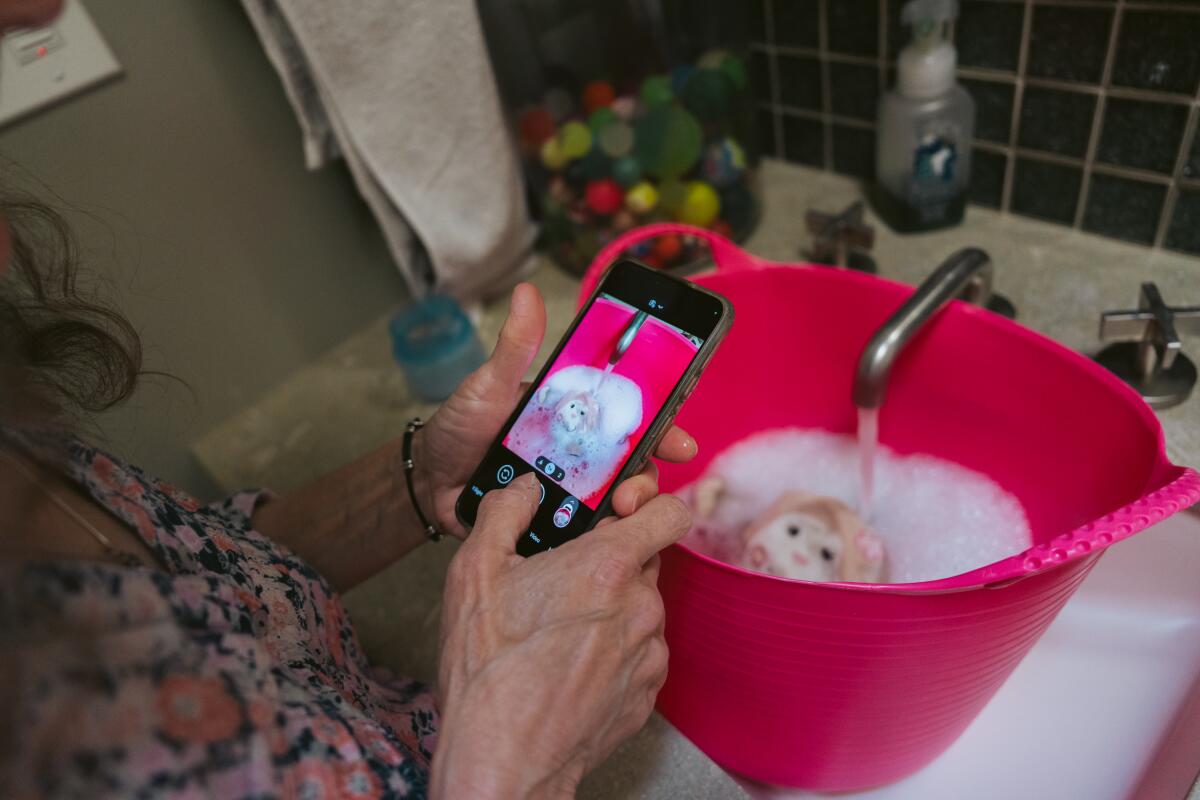
Sales for plush toys between 2021 and 2022 rose by 31%, according to the NPD Group’s U.S. retail tracking services, which covers part of the U.S. toys market.
Susan Adamo Baumbach, acting chair of the toy design department at the Fashion Institute of Technology in New York City, said people connect with plush toys in a variety of ways, be it the design, an animal they’ve always loved or something that was gifted to them. She said plush toys “age in a different way” than building blocks, games or sports equipment because they change slowly over time “and then it’s like, wow, this piece of plush has been loved and loved and it shows it.”
Adamo Baumbach added that the biggest misconception people often have about stuffed animals and other plush toys is that they’re only for kids and not adults. She pointed out that some households may be eager for their child to grow out of a toy but chances are, that will not happen, or there will be resentment if they’re forced to give up a toy they love.
“Maybe it’s an animal that we’ve had no interaction with or no love of but there’s something in that face, there’s something in that styling, there’s certainly something in the eyes, that is almost like falling in love at first sight,” Adamo Baumbach said.
At Realms of Gold, each patient is special to Karpas, but there have been some standouts over the years. There’s the blue bunny she pieced back together based on a picture of its owner’s tattoo; the stuffed rhinoceros that had 30 years of adventures at the front of a big rig truck and needed to be cleaned so it could go with the retired trucker; the favorite stuffed toy a firefighter’s family wanted cleaned up so they could present to him when he came home; the favorite teddy bear a woman found in boxes she was going through after her mother died that needed to be stitched up.
Karpas’s days include running soak baths for patients, stuffing patients, sewing, sending cost estimates for prospective patients, and packing patients for their journeys home. She also emails people with suggestions about fixing their plush friends and what kind of customizations can be made.
Being responsible for someone’s cherished toy comes with its own pressure.
“I try very hard to be very explicit about what I can and can’t do, and I also try very hard to be very explicit about what’s reversible and what’s not,” Karpas said. “I don’t want to do something that’s not reversible and have the person be unhappy, because you want it to still be their stuffed animal.”
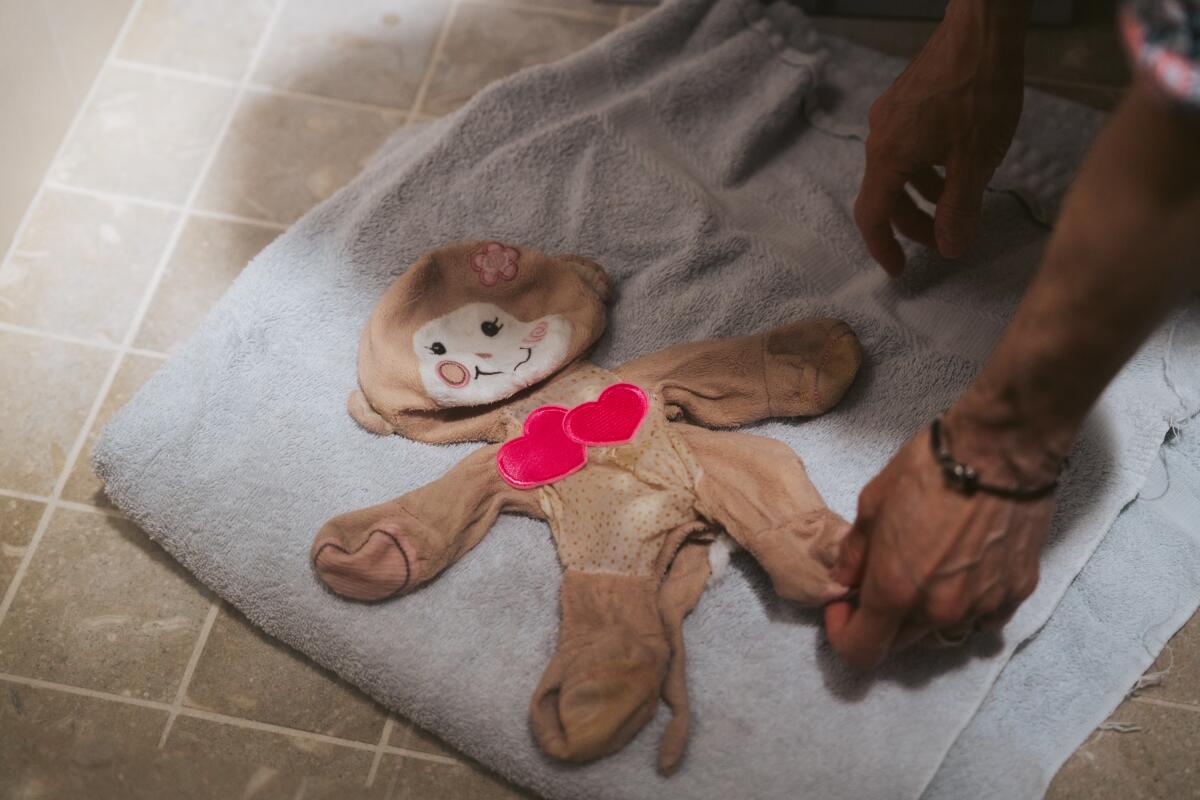
The rejuvenation process depends on the patient but Karpas sticks with her usual regimen. Most patients get a spa soaking to help with cleaning, refluffing their stuffing and getting the dirt off so their original color can be restored. The photos of patients sitting in bubble baths — nothing but their eyes and noses visible — are a popular part of Karpas’s Tumblr site, and clients often like getting reassurance that their stuffed friends are doing well.
“That’s something that’s cute, and most people aren’t freaked out by,” Karpas said. “I don’t send pictures of patients drying, because they look like fabric is cut out… All but one of their seams is closed, but they look flat, and that’s not the animal you remember, so most people don’t want to see that.”
The filling and more colorful parts are removed to help with air drying. After that, the toy is restuffed, with extra filling added in. Before being sewn shut, Karpas will add a heart-shaped pouch with the patient’s previous stuffing, a suggestion made by a client that has stuck with her.
“Most of the time, people want their stuffed animal a little chubbier than it was, because stuffing compresses over time, and that’s part of how they get flat,” Karpas said. “They’ll be like ‘They lost all their stuffing,’ and I’m like, ‘No, you’ve just hugged them a lot and the stuffing is all compressed.’”
A patient might need new eyes or a new nose. Karpas said this is an important step for clients because these parts are held in place by safety washers and designed to not come out easily. Karper added that getting an exact match for an old nose or eye depends on availability or when they were manufactured.
“There are some people who will say, ‘Well, that’s really your soul, and let’s just keep them like that’ or sometimes people will say, ‘No, they really need to be able to see; the cataracts are bad,’” Karpas said. “You could just replace the eyes, and most people would never notice, but I can’t do that because these are their memories, and I don’t want to change them without them.”
Years of helping patients has also taught her best practices for how to tackle specific issues.
If Karpas can’t remove a patient’s stuffing, it can’t get a spa soak. The legs on Raggedy Ann dolls are made of red and white-striped fabric, which will bleed when it gets wet from tears or attempted washings — better to replace them with new fabric.
She bulk buys 10- and 20-pound boxes of hypoallergenic stuffing. There are bulk orders of stuffed animal eyes, but now with clear ones available, she can mix colors to match old eyes or make new ones. Shorter ply fur for stuffed toys missing patches or torn up will eventually blend into the rest of the fur with time and hugs. Commercial toys often have flat eyes that may need to be remade with felt. Helping a Barney patient often means buying a new Barney to be a donor to fix missing patches since the dinosaur’s color is proprietary. She’s bulk ordered sound boxes for teddy bears from Germany just in case an animal patient lost its voice.
“For a while, I had to source [koala] noses from Australia because nobody here had koala shaped plastic noses,” Karpas said. “You didn’t want a regular triangular teddy bear nose or a puppy dog nose or a cat nose, you need a koala nose… I ordered a whole bunch of noses, so I have koala noses for any kind of koala that comes in.”
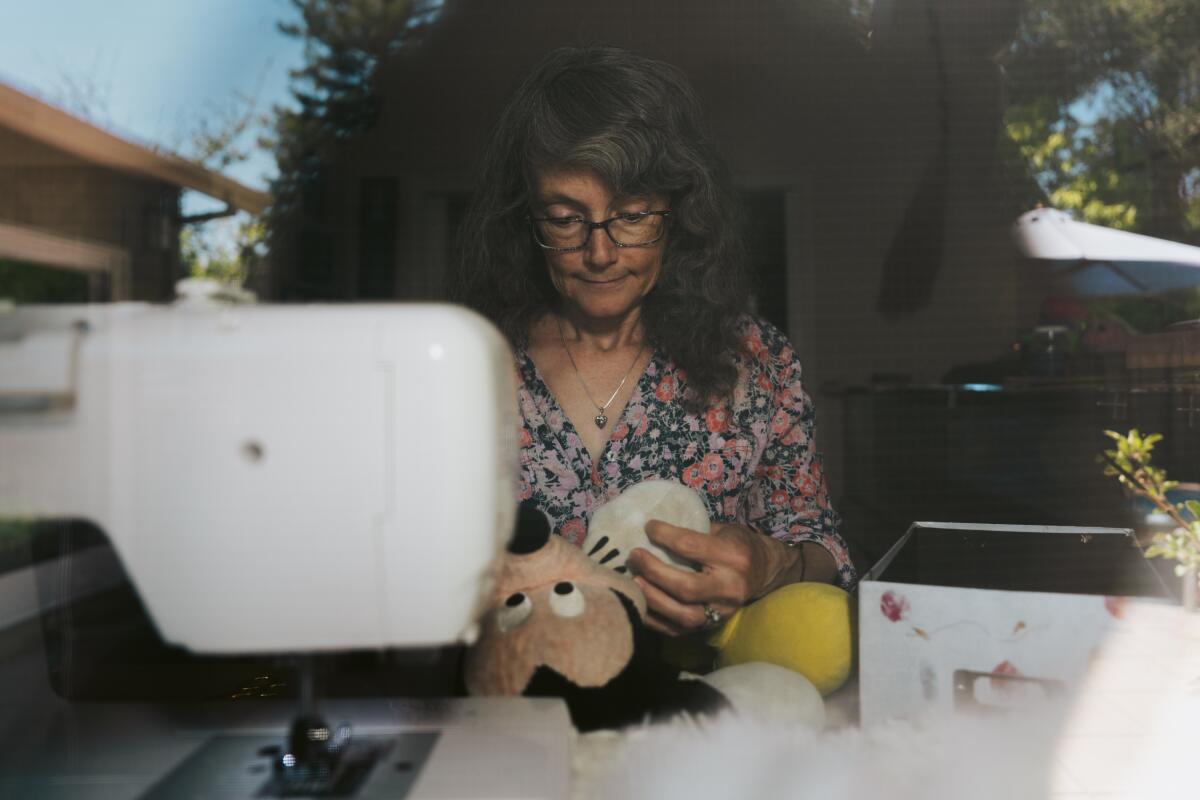
When patients leave, Karpas sends it home with a copy of its chart and discharge instructions. Those include keeping patients at a comfortable temperature and humidity, out of direct sunlight and out of hot attics, cold basements, washing machines and dryers. For patients that were on an increased stuffing diet during their hospital stay, Karpas notes that “lots of hugs will aid in [their] continued healing and help them lose any weight gained.”
Karpas said she’ll continue to run the hospital until she’s tired of the work. Knowing she has helped thousands of toy patients return to their owners in better condition has made her proud.
“I was doing a really good job of increasing the total amount of happiness in the world,” Karpas said. “That’s the goal of the hospital, and if there’s over 6,000 patients out there, and there are people that are happier and together still because of me, that was a really good thing. I made a difference in the world.”
More to Read
The biggest entertainment stories
Get our big stories about Hollywood, film, television, music, arts, culture and more right in your inbox as soon as they publish.
You may occasionally receive promotional content from the Los Angeles Times.











